


Covert Action puts the player against a series of terrorist conspiracies, one after another. Each time you start with a vague, undefined yet very present ticking clock working against you, maybe a handful of clues of varying value, and all the air travel the Agency can afford. From there you're expected to draw whatever conclusions you can from what little is known and then hit the ground running. Sometimes that's easy. "We know this guy is involved, here's his photo, he's in Brazil. Traffic analysis says the Shining Path is making huge money withdrawls." Sometimes you have to go in a bit blind and feel around. "Here's a codename of an otherwise unknown enemy agent we think is somehow involved. A car was stolen three weeks ago in Europe. Good luck?" Gameplay consists of a series of minigames - there are top down stealth / shooter sections, circuitboard design sections where you swap out chipsets to activate your trackers while avoiding triggering alarm nodes, cryptograms to break captured message traffic, 'follow that cab' tailing / driving encounters. Each has a wide range of difficulties that scale with the 'threat level' you chose when you started playing, and you're given a 'specialty' when you start the game that makes a particular mini game of your choosing easier. Defeating a conspiracy gives you the option to step up a difficulty level on the next operation. Although the stealth/shooter bit is unavoidable, the game does a good job giving you ways to work around any other minigames you don't enjoy or have difficulty with. Trailing a car can usually be bypassed by placing a bug on it instead. Crypto breaking can be automated, although this burns time pretty aggressively, or you can just track down the sender / recipient and 'ask them politely' what it says. Because of how clues are handled, you don't have to follow up on every lead, and might not have time to anyway. I personally hate the driving sections and can still enjoy Covert Action - I just avoid them wherever I can and just fail them right away when I can't. Failing a minigame always comes at cost, but never out and out loses you the game. If you get shot up you'll be taken hostage and either have to escape (which takes time) or agree to give them enough info that they can inflitrate the Agency with a mole. (Mole hunts are another aspect of the game - distractions from your actual mission, but important to avoid being ambushed and the enemy tracking your movements.) Setting off alarms makes the enemy call in extra security, complicating future operations. And all the while the Conspiracy continues to develop. Each conspiracy has a chain of events the enemy needs to complete to be successful, and you can break the chain anywhere. Steal the bank plans back and they won't be able to proceed to the bank robbing stage. Arrest the paymaster and the mooks will stop coming in to work. Once they know they've been bested, named enemy operatives will disappear into the shadows, biding their time until they can strike again. "Masterminds" lead each operation, and while your medium-term goal is to stop the terrorist attacks your ultimate goal is to take each Mastermind down so they can't keep launching these operations. This gives each session a nice range of how things can end - you can lose and innocent people die, you can stop the conspiracy while learning a little bit more about the mysterous person behind it while they escape, or you can shut down the whole institution by lopping off it's head. It's a five out of five for me. Lots of ways to play it, in terms of difficulty level and what kind of balance you want for the minigames. You can play for an hour to just efficently stop an attack, or buckle down for a few hours and take down an entire international terrorist organization. It runs on a potato. I've never had a bug playing this across four computers and multiple years. My only caveat would be that I think if you didn't enjoy multiple minigames, or disliked the sneaking / shooting sections, you wouldn't have a good time. If you're into older games, though, you should be okay, as each of them (possibly excepting that darn driving game) is well put together and fun in it's own right. I really want a remake of this. It could even be in spirit and not in name to bypass IP related expenses, the ideas here are so broad it would be impossible to C&D a modernized semi-clone without trying to claim copyright to the entire genre of spycraft fiction.

If you've played Ringlorn, you know approximately what to expect in terms of presentation and moment-to-moment gameplay from its Gaiden game. Things are different this time around - the familiar layout is markedly changed by events and time between games (assuming this one comes later, which I'm not entirely sure of). You have the power to emulate a monster after dealing a fatal blow while in your 'natural' form, which makes up most of the 'puzzles' of the game. Being 'after the end' there are far fewer NPCs to talk to. It's a much lonelier, darker experience. Pretty darn open world, though. I stumbled up to the final boss (with lots of tactical dodging throughout his fortress) at something like level three. I'm glad I lost that fight, since wandering around gaining levels and tools eventually granted me some clarity on what had happened in the first place to make everything so bad, and while the plot isn't going to shake your perceptions of what kind of stories games can tell, it's pretty solid. I would strongly recommend against playing this before going through the 'normal' version of Ringlorn. If you beat that though, and liked it, and can approach this as more of a DLC / sidegrade-game than a straight up sequel or continuation, I think you'd like Gaiden too. A small hint - There's an Aggressive and a Defensive mode, and since killing the enemy quickly and dodging it's attacks (instead of trying to soak them with your HP) is the name of the game, you'll probably quickly forget there even is a Defensive mode. Remember it exists when you're trying to talk to the few NPCs there are!
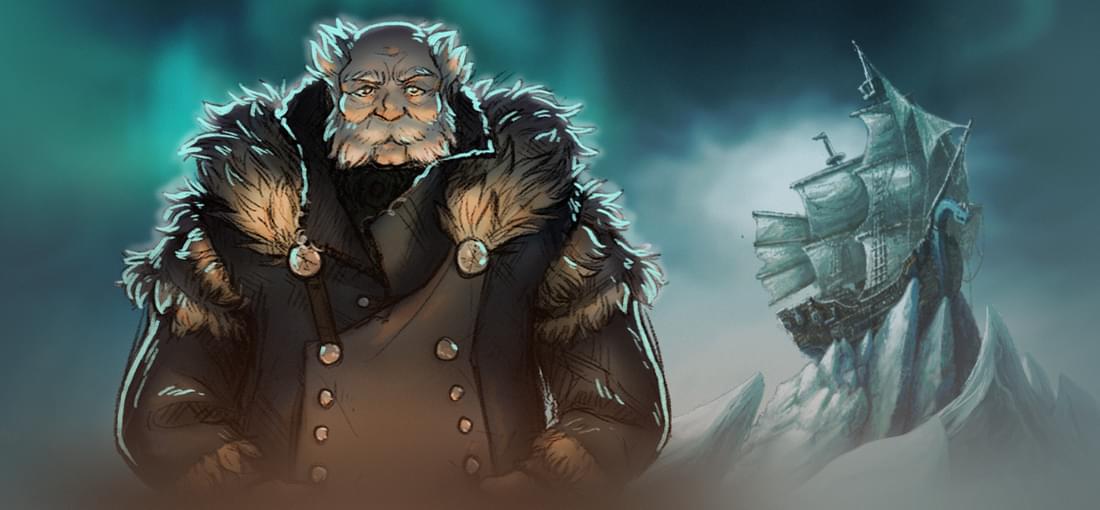
Fantastic. A strategy survival game that doesn't want you to get complacent, or maybe a deep visual novel that wants to kill you. It takes roughly one lazy Saturday to crank out a front-to-back playthrough. If you enjoyed Banner Saga, Pyre, and the man-vs-nature aspect of Frostpunk, The Pale Beyond is probably up your alley, while remaining very much it's own special thing. Plotwise, you try to keep a tentative rescue crew headed into the Antartic alive after the captain vanishes and things go very, very wrong with the mission. It's largely a worker placement and resource management game, where your margins run pretty tight, but it's also full of difficult bespoke choices to make. Where I think it shines best is in how the game represents the crew - there are roughly two dozen aboard, and each has very detailed and distinct character art, beliefs, priorities, ways of speaking, and ways they prefer to be spoken to. Some of the hardest moments (for me) are when you have an array of responses boil down to the same thing (not commonly the case, but it happens) but the way you say the thing affects the way the recipient receives it, which will have consequences down the line. Great stuff! I'm no Shackleton. Five members of my crew died before the end of the game, but I believe I could have saved them. Can save them, if I try again. There's a wonderful branching save system that lets you be a purist and suffer consequences, or 'branch' reality from any point in the past and try again from there, so knowing in hindsight where I messed up will let me jump straight to that point instead of having to do a full restart. As the story develops your options change - things you had presumed you'd always have access to are lost, opportunities not exploited are gone, new opportunities appear. It never feels like the game is being unfair or arbitrary, more like the nature of the crew's mission in such an uninhabitable space is pushing back against your attempts to survive. The programmers don't hate you, the cold and the ice hate you, and when everyone survives another week it feels earned. When they don't, you feel it, since each crewmate is, or rather was, a unique individual. The juice of the game is excellent. Options swell slightly as your mouse gets nearby. Speaking characters become maybe 5% larger, their clothing slightly more vibrant. Paying attention to the ambient background noise or subtle shifts in the art will sometimes foreshadow plot developments. It will occassionally surprise you with one-off, bespoke interactions unlike anything else in the game. Lots of small, nuanced things that make it very clear what's happening, provide positive feedback for the player, and keep things interesting. Problems? Some, all pretty mild. Removing a crewmember from a task can be a bit buggy, with their profile sometimes disappearing altogether or sometimes doubling up like they have a twin helping them. Backing all the way out of the menu corrects this, so it's not a softlock or anything, but it's weird when it happens. A few unique options slam your turn to a halt without warning, which is potentially lethal if you haven't added food to the mess or coal to the burner yet - that's annoying, but the save system means you can correct for it within four or five minutes. The thing that Pale Beyond does that I think I love best is this : You are constantly preparing for an unknown future, and the game makes it abundantly clear that it's going to throw suckerpunches. You're making intelligent, reasoned decisions in staffing, who takes what risks, how to deal with each individual crewmember, where and when to be tightfisted or generous, and how that's all going to ultimately be tested is this vast known unknown (at least on the first playthrough). There are obvious ways to fail, and you're constantly juggling slim margins to keep ahead of all the ways things can go south that you know about, but because of the way the game keeps upsetting the apple cart in a barely-fair but gripping manner you can find yourself cursing or cheering when a decision that you made (or the emergent results of a series of decisions you've made) come(s) to fruition in a decisive moment you could only now, in hindsight, have seen coming. Lots of this type of video game feel like a digitized Eurogame - you're making decisions to maximize your output within the context of a known game economy. The Pale Beyond is that, but it keeps throwing expansion packs into the game, and sometimes loses pieces or introduces house rules, and you're also playing D&D with a DM who wants you to win but isn't going to fudge any die rolls. It's thematically perfect for playing out the adventure of a team of highly prepared and competent individuals sailing into the vast unknown of an unexplored polar region where anything could happen. I don't think The Pale Beyond fits neatly into any one specific game genre, but I hope I'm wrong, because if it does and I figure out what that genre's called I can go out and immediately dump my game budget for the next year on anything tagged with that label.

I can't recommend this game. This is an interesting concept, but should have seen a lot of additional iterations before being released as a paid product. - Visual aberations are frequent. It has some clearly intentional "whooo spooky" digital glitching that's unsuited for the narrative context, but it also will randomly fail to understand how lighting works under a shelf or inside a container, flickering the area in and out of existence. Things in the darkness become LESS visible as you get closer. Just, a lot of visual oddities. - If you walk up to a window to look at the skyline, a second later the skyline blurs, like you're depth of field has shifted to the invisible glass. It's headache inducing. I'm a big fan of first person games and neon drenched bullet hell arcade games, but there's something about There's A Gun In The Office in particular that stabs me between the eyes. - The button to use your held object, put it down, or (with one exception) use the thing you're looking directly at are all the same button. With that being the case, it's vitally important, especially in a game centered around completing tasks in a tight window of time, that the game understand the difference between "Perch the held key on the edge of the open drawer's handle", "Close the drawer", and "Put the key down inside the drawer". This game frequently fails that test. I have repeatedly looked directly at an object, gotten the context sensative notification that pressing the action button will move the object, and had the MC drop a small vital item on top of the object instead. I've placed keys on top on knobs instead of unlocking the knobs. Just... lots of that stuff, and it's constantly infuriating. You're not racing your kidnappers, you're playing a bad version of QWOP or Surgeon Simulator. - The room you are detained in has a bed. A very small part of it near the foot, nowhere near where you would intuitively associate with any "Get into the bed" action, has a hotspot that results in you getting into the bed, which ends the day. This is important, because your captors freak out and kill you if you're awake at 5pm when they get back, even if you're right where they left you. You can learn this, right? That you need to click the inside edge of the foot of the bed to end the day? But it's a perfect example of the kind of 90s point-and-click "guess what I'm thinking" logic the designer sometimes slipped into. - There are options that highlight when your mouse hovers over them, but that cannot be selected with the mouse. They need to be activated with a context sensitive keyboard button, despite highlighting when you hover over them like every other piece of software you've ever used. - The program is "UE" in the task manager / alt-tab navigation menu. (Not a big deal, I know, but it supports the argument - there are six playtesters listed in the credits, but it's so hard for me to believe that six people played this front to back and missed all these red flags. Not having your program titled properly on execution is a big 'Brown M&M'.) - You can clip into furniture (but clipping back out is not assured.) - Your vision glitches like you're a synthetic lifeform at the far end of an EMP rifle whenever anything 'stressful' happens. It's all digital effects and television static, nothing like shorthand for an elevated pulse. - You can find the gun... drug your kidnappers... get to the exterior balcony from which anyone without broken limbs could escape... or all three, and still lose because you didn't close a door. Or because you're hungry and ~really~ wanted a moldy apple, so instead of escaping you're gonna pout. - The arbitrary limits set to control the pace are infuriating. At one point you can't proceed because a small children's sized backpack is on top of the thing you want to manipulate, and it would just be too much effort to move that twelve inches. At another you need one last key to get the gun, so you just GIVE UP under the assumption that your kidnappers will conveniently leave it laying around at some future point, so it's back to bed with you. - The toilet paper model is hung with the loose end wall-side (underhand fashion), which is unforgivable. - Every day you have to steal a small piece of food, or you get caught by your kidnappers trying to escape (yeah, it doesn't make sense). There is enough food in the kitchen to feed a family of three for a week, but you can't eat any of it because it wasn't marked as a quest item by the programmer. You can starve into... being caught... by your already successful kidnappers... while surrounded by food. - You have to stand pretty close to an interactable to activate it. Because of this, doors seem programmed to shift you out of the way if you're in the way while they open... except for one, which closes itself instead if you don't throw yourself out of the way as soon as you click the handle, and one that opens away from you but reverses and shoves you back into the hallway behind you if you touch it by moving forward into it, in the direction of it's current motion. Got that? Moving WITH the door, pushing it forward as it rotates forward, causes it (and you) to move backwards. Just that one door. I've griped a lot here, but the synopsys is this: I didn't go a solid minute at any point without thinking "Really? This (new specific thing) got through to your final product?" I gave up on the final day because I couldn't escape, despite doing everything practically necessary to do so, because I couldn't find the last hidden apple/orange so the game refused to let me escape. On another game I might power through, but given all I've seen I'm not sure at this point that the necessary food item actually exists or if they miscalculated how many moldy apples to put in and never did a front-to-back playthrough during testing. A hard skip at anything more than a dollar, maybe a dollar and a half. It feels like a two buck itch game that started as an asset flip.
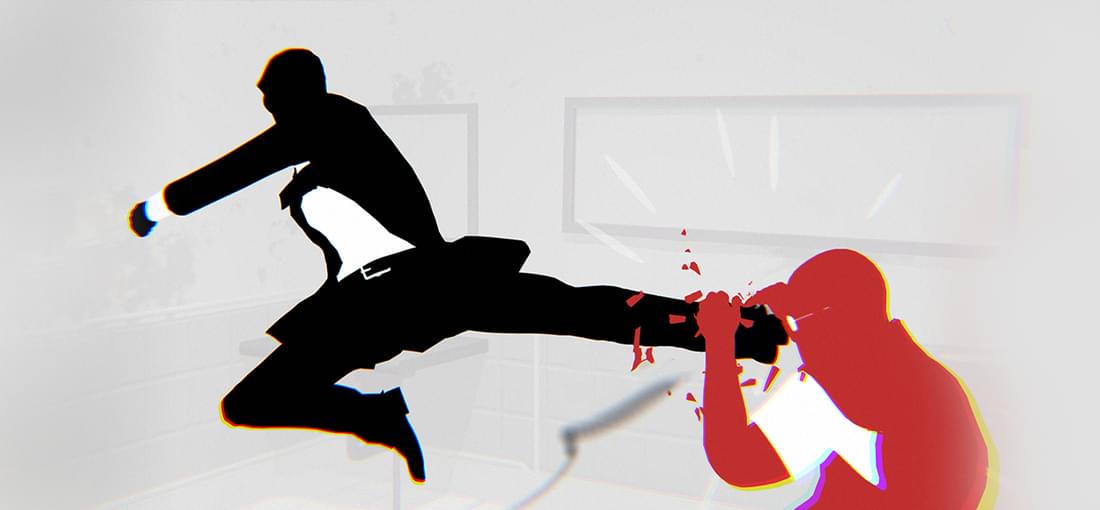
With the aesthetics of SuperHot, the tactical planning of Into The Breach, tight deckbuilding elements that leave the player feeling constantly better equiped while simultaneously not being able to get everything they want to ensure future perfect play, and a soundtrack that is both simple and somehow doesn't get old after twenty plus hours of play, Fights In Tight Spaces is a no kidding masterpiece. The plot's very wink-wink-nudge-nudge, a shiny gloss over the gameplay that doesn't take itself seriously. The pacing is nearly perfect - you're never more than maybe three seconds from making a decision, and if you hold the space bar to fast forward you can breeze through even the minor moments of delay. A game like this mostly succeeds or fails on it's balance, and this one succeeds beautifully. I've beat it with most of the default decks already, and the ones I haven't won with I've failed by virtue of my own errors. Luck *is* a factor, but a surprisingly small one for a game designed around card draws. Nearly every single time you lose you'll be able to look at the board on the last turn and identify where you went wrong - the step you should (not) have taken last turn, the way you failed to balance your cards with your 'momentum' (the currency you spend to play said cards). A range of difficulty options let you pick a level that fits your confidence, and the plotless "Endless" mode is a nice alternative where doom is assured but you can get surprisingly far with good adaptability and a small bit of luck. I usually intend to play about an hour a session, but it has a way of One More Round-ing you for up to around two and a half hours. It does the Tactical / Strategic cycle thing well. Tactically : Which of my cards do I play this round, and in which order, to avoid damage / maximize damage / secure better positioning? Strategically : What route do I take to the Big Bad, maximizing my rewards for the playstyle I'm going for this time around while not biting off more than I can chew. How do I convert those rewards into a better deck - more cards, less cards, better cards, (..etc..)? I got this on sale, but it's probably worth full price. At around a bug-free 20 hours, I've really enjoyed my time with it, and am unlikely to uninstall it any time soon. The developers get auto-buys from me going forward, as long as they can keep up this level of depth and polish.
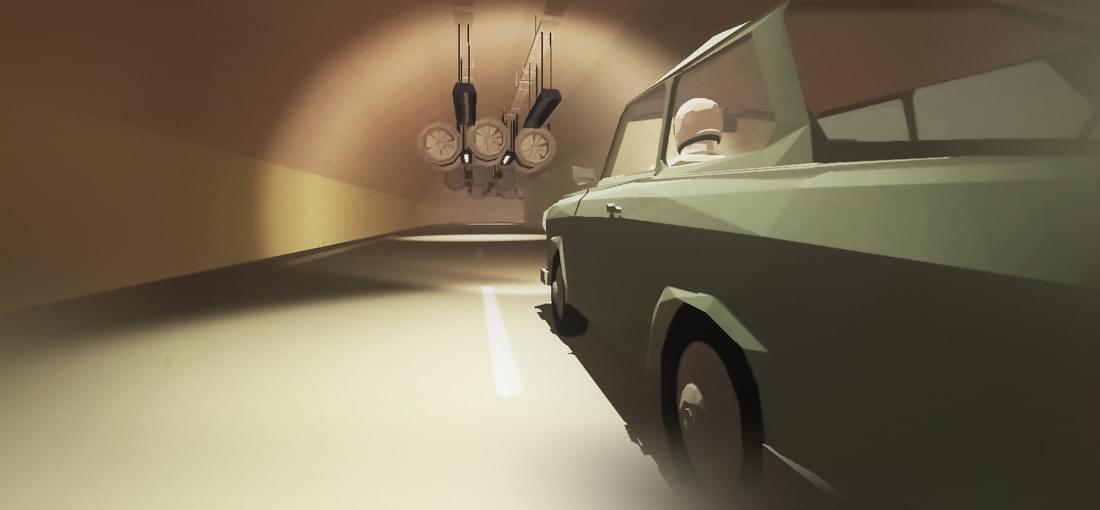
Jalopy is hard to play. Not that it's HARD, exactly, but it's dull enough to cause the kind of existential dread about your life wasting away that Russian and Eastern European games and literature sometimes strive for, but in a metatextual way independent of the gameplay itself. I should love this. I liked Quadrilateral Cowboy, so I should be all about the chunky graphics. I liked FTL and Oregon Trail, I enjoy the overall "get from A to B despite C D and E" playstyle. I enjoy Idle and Incremental games, a little time-sink-crunch shouldn't drive me away. I adore games with embodied interaction interfaces like Inscryption, the way the game handles managing 90% of the controls should really jive with me. But Jalopy is just too unengaging to engage with. Play consists of Doing The Obvious to keep the car going, then holding W down to progress. Pay enough attention to not drive into a railing, but it's not exactly respendent with navigational challenges - it's more like turns in the road exist so you don't put a weight on the W key and wander off to do something else between moments of occassional low grade engagement. There's so little game here, and it needs so much attention, for so little payoff, with such little to endear it, with such a slow and unrewarding gameplay loop. It's not worth investing the time. Maybe try The Legend of Bear Truck Trucker instead for your 'drive around, getting by' fix instead?
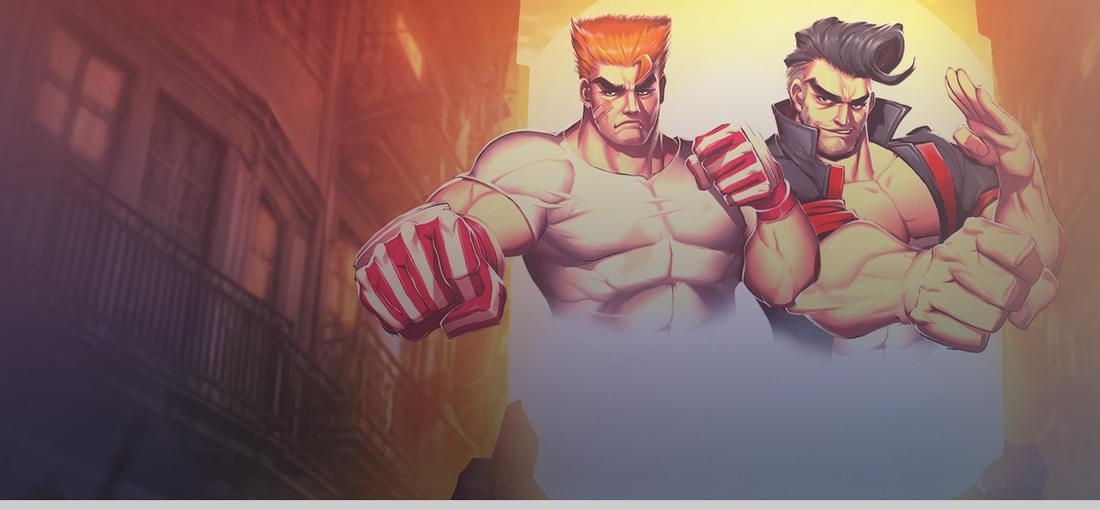
RCR is a classic for a reason, but runs a little short. You could beat it between getting out of school and dinnertime. How do you lengthen that experience out to a modern 'full game' where 20+ hours is the standard? In RCRU, they - - Added leveling that caps how much benefit you can get from food. You know, RCR's whole thing. Just overcomplicate the primary gameplay loop by introducing a pointless additional layer that is advanced in the same way as an already existing layer (ie punching dudes). - Have enemy AI that escalates with plot advancement. Could have worked, if the late game AI didn't have instant-reaction insurmountable blocking skills, couldn't backstep at full running speed as soon as the player starting a swing or a grapple attempt, didn't launch combo-breaking counters, and didn't start flanking and using specials like a real human was playing them. - Have a bunch of characters to choose from, including unlockables. Great idea! Not at all balanced! And you're pretty well locked into who you blindly chose at the start because of how worthless a level 1 PC is by midgame. It's "difficulty by roulette spin" design. - A day-night cycle that affects whether shops are open and whether certain mandatory boss fights are possible. This just results in thumb twiddling while waiting for the clock to advance. - Have the enemies stop dropping money in the late game. And introduce a guy with perfect block, massive health, who duplicates himself if hurt but not rapidly defeated, a firearm (that the player can't take), a maybe two frame wind up for his half-the-screen special attack. Make him a standard respawning enemy that spawns everywhere, including inside shops. - Forced elevator sequences, with waiting between enemy waves. A final boss that involves a half hour of slowly grinding through most of the map, with no chance to heal. It's pretty, and the creators clearly love RCR, but having plowed through it I'd rather have just replayed the original.
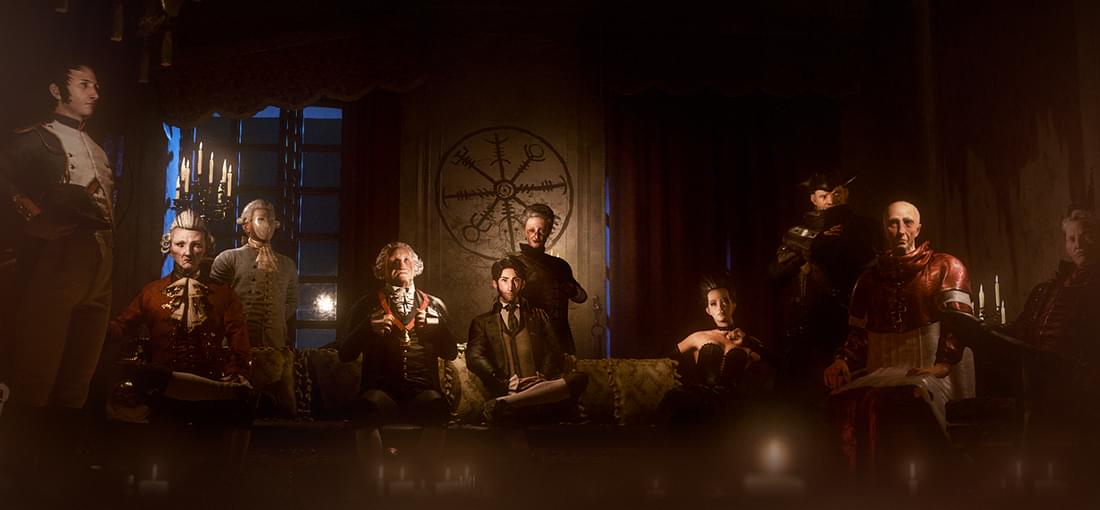
"The Council" plays like The Colonels Bequest took place in Cultist Simulator, art from IcePick Lodge Pathologic 2 era, with RPG elements ripped from Cute Knight / an '00s flash dating sim. The main character is a Golden Dawn cultist hunting for his vanished mother at a proto-Bilderberg conference. He gets thrust into her place in the meeting, having to juggle his search, his nation's interests, and the welfare of the cult. Great premise, and for half the game well executed! Gameplay wise it's a social stress simulator, in the best of ways. You know nothing and saying the wrong thing will have serious consequences. Finangle your way through bespoke, unique interactions with The Elite, building up knowledge of what's going on and how to exploit the conversational foibles of the various players. Escalation is well timed - as you gain enough awareness to make good decisions the decisions themselves get tougher. The game autosaves, no manuals, so you have to live with your choices. It IS possible to backtrack to a chapter break, but these are far apart, so changing your mind is costly and burdensome. As noted in other reviews, there is a twist that recontextualizes everything prior, which isn't necessarily bad, but coming at the halfway point it is also when the writers had to start trimming back the branching narrative so it can all end at The Big Ending. Much of the gameplay becomes padding between important choices, and the effects of those choices erode away quickly. The positioning of characters in conversations start to drift, with people speaking over each other's shoulders. New locations stop being introduced. The MC starts just knowing things and making decisions contrary to the player's. It feels rushed, and we never get decent closure on the first half before it goes from eliptony-spycraft to an almost-gonzo railroaded walking sim. As two games, the first half is 5/5, the second.. 2/5? Maybe 1/5 for unnecessary blasphemy.
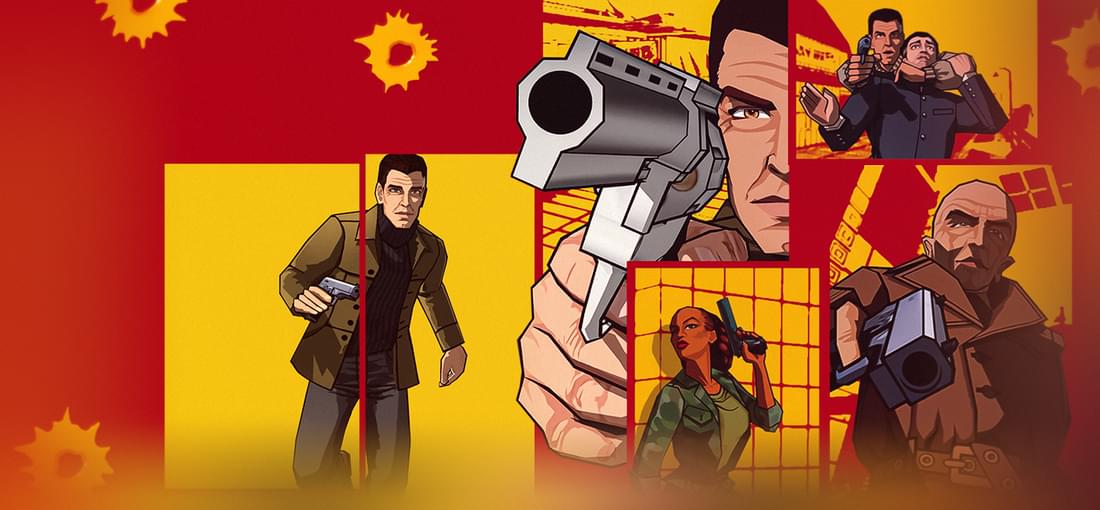
XIII has a wonderful cell shaded style, a wide range of weapons to toy with, varied environments, a fun scat-jazz inspired soundtrack, and it promises a griping conspiracy-based spy thriller plot. Unfortunately, the weapons end up bland despite their variety, the enemies hitscan so combat is just a game of 'choose a range appropriate weapon and click on their head for a bit', and the plot is more of a set of mashed-together tropes than anything coherent. The big problems IMHO are threefold. 1 - It's mostly a FPS, and the shooting is kind of lame and overly easy. 2 - It couples checkpoint-only-saving, forced stealth sections, and AI / Hitbox jank together into a series of horrid "replay the last ten minutes AGAIN, for the fifth time, because this guard randomly saw through a wall this time around" experiences. 3 - Extremely linear. Not just in that the game requires the player to go from A to B to C, but in that you can lose missions and be booted back ten minutes because you didn't trigger a positional flag, in ways that don't make sense narratively or gameplay wise. There are other issues - Duchovny either phoned in his line reads or only had isolated, out of context snippets to read. (If released today, I'd assume they used a TTS AI to 'read' his part.) Lots of almost Xen-esque jumping puzzles. You can defeat the conspiracy really, REALLY early on, and you get a game over for doing so. Lots of unskippable cutscenes, including in the middle of stealth sections. It ends on a never-to-be-addressed cliffhanger. For all that, it does have a strong, nigh unique presentation that keeps things relatively interesting from start to finish. Remembering the limitations of the hardware it was originally designed for, it's an impressive piece. 3 out of 5 as a game, ~4.5 out of 5 as an artifact of its time.
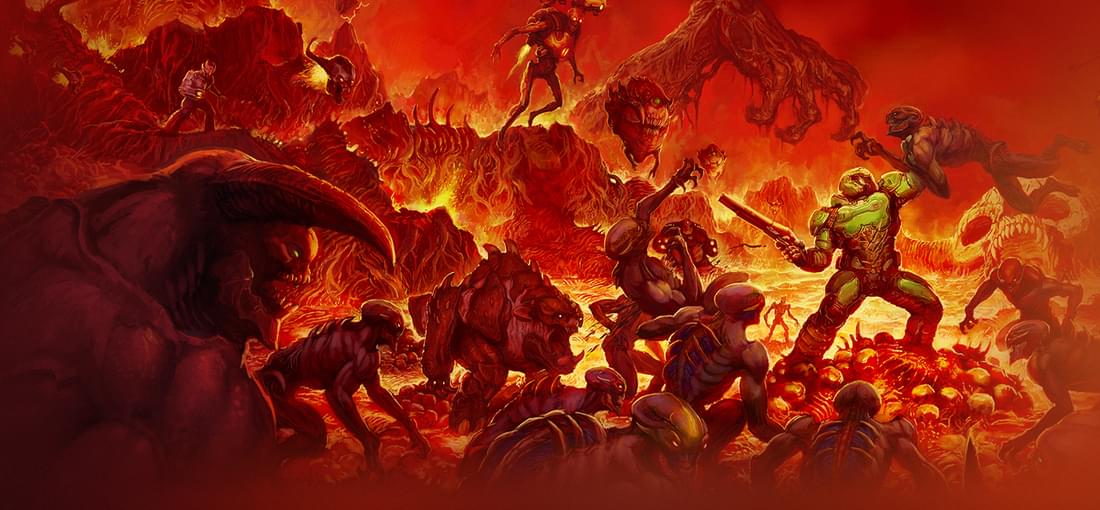
Doom ('16) is a quality production. Level design varies within a 'type', so a given section of the Martian surface is distinct from a different iteration. It also fluxuates between broad 'types' regularly - Union station interiors, the surface, Hell. Areas are generally pretty open, with multiple ways to get around, and the way forward is cued to the player in a number of different (mostly) subtle clues that minimizes the "Everything's dead here, how to I progress?" time. It's clear they both spent a lot of time on the 'theory side' of level layout and playtested this thing to Hell and back with newbies / fresh eyes. The weapons are great. Even the peashooter feels a little meaty when it goes off at full charge. The game encourages swapping guns multiple times during a fight, and the way they handled the transistion (holding "Q" gives you a weapon wheel that slows down time ~almost~ enough to switch safely) always felt fluid. Each weapon continues to bear up until the end of the game. Sound effects are great - audio cues are distinct and appropriate for the game, and everything ties thematically to what's putting it out. The music is solid throughout, even if nothing approaches M1E1 levels. Enemies fight differently enough to mandate the player switch up tactics in the spur of the moment, and facing a handful of different types simultaneously adds some wonderful tension. The lowly imp remains a risk until the end, where it is the weakest thing facing you but still aggressive enough (and nimble / defensive enough) to be a constant tax on your HP if you deprioritize them. No hitscanners either! One noncritical bug noticed on my whole playthrough. That's pretty good for the length of this beast! Negatives? If you're looking for a "true sequel" to the original, this is too easy, albeit still massively fun. Huge memory hog, RAM and hard drive.